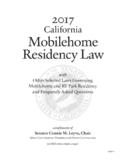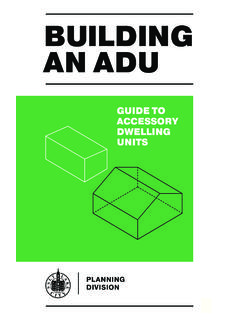Transcription of Frequently Asked Questions: Accessory Dwelling Units
1 Frequently Asked Questions: Accessory Dwelling Units Should an Ordinance Encourage the Development of ADUs? Yes, ADU law and recent changes intend to address barriers, streamline approval and expand potential capacity for ADUs recognizing their unique importance in addressing California's housing needs. The preparation, adoption, amendment and implementation of local ADU ordinances must be carried out consistent with Government Code Section : (a) The Legislature finds and declares all of the following: (1) Accessory Dwelling Units are a valuable form of housing in California. (2) Accessory Dwelling Units provide housing for family members, students, the elderly, in-home health care providers, the disabled, and others, at below market prices within existing neighborhoods. (3) Homeowners who create Accessory Dwelling Units benefit from added income, and an increased sense of security. (4) Allowing Accessory Dwelling Units in single-family or multifamily residential zones provides additional rental housing stock in California.
2 (5) California faces a severe housing crisis. (6) The state is falling far short of meeting current and future housing demand with serious consequences for the state's economy, our ability to build green infill consistent with state greenhouse gas reduction goals, and the well-being of our citizens, particularly lower and middle-income earners. (7) Accessory Dwelling Units offer lower cost housing to meet the needs of existing and future residents within existing neighborhoods, while respecting architectural character. (8) Accessory Dwelling Units are, therefore, an essential component of California's housing supply. (b) It is the intent of the Legislature that an Accessory Dwelling unit ordinance adopted by a local agency has the effect of providing for the creation of Accessory Dwelling Units and that provisions in this ordinance relating to matters including unit size, parking, fees, and other requirements, are not so arbitrary, excessive, or burdensome so as to unreasonably restrict the ability of homeowners to create Accessory Dwelling Units in zones in which they are authorized by local ordinance.
3 7. Are Existing Ordinances Null and Void? Yes, any local ordinance adopted prior to January 1, 2017. that is not in compliance with the changes to ADU law will be null and void. Until an ordinance is adopted, local governments must apply state standards (See Attachment 4 for State Standards checklist). In the absence of a local ordinance complying with ADU law, local review must be limited to state standards and cannot include additional requirements such as those in an existing ordinance. Are Local Governments Required to Adopt Courtesy of Karen Chapple, UC Berkeley an Ordinance? No, a local government is not required to adopt an ordinance. ADUs built within a jurisdiction that lacks a local ordinance must comply with state standards (See Attachment 4). Adopting an ordinance can occur through different forms such as a new ordinance, amendment to an existing ordinance, separate section or special regulations within the zoning code or integrated into the zoning code by district.
4 However, the ordinance should be established legislatively through a public process and meeting and not through internal administrative actions such as memos or zoning interpretations. Can a Local Government Preclude ADUs? No local government cannot preclude ADUs. Can a Local Government Apply Development Standards and Designate Areas? Yes, local governments may apply development standards and may designate where ADUs are permitted (GC. Sections (a)(1)(A) and (B)). However, ADUs within existing structures must be allowed in all single family residential zones. For ADUs that require an addition or a new Accessory structure, development standards such as parking, height, lot coverage, lot size and maximum unit size can be established with certain limitations. ADUs can be avoided or allowed through an ancillary and separate discretionary process in areas with health and safety risks such as high fire hazard areas.
5 However, standards and allowable areas must not be designed or applied in a manner that burdens the development of ADUs and should maximize the potential for ADU development. Designating areas where ADUs are allowed should be approached primarily on health and safety issues including water, sewer, traffic flow and public safety. Utilizing approaches such as restrictive overlays, limiting ADUs to larger lot sizes, burdensome lot coverage and setbacks and particularly concentration or distance requirements ( , no less than 500 feet between ADUs) may unreasonably restrict the ability of the homeowners to create ADUs, contrary to the intent of the Legislature. 8. Requiring large minimum lot sizes and not allowing smaller lot sizes for ADUs can severely restrict their potential development. For example, large minimum lot sizes for ADUs may constrict capacity throughout most of the community. Minimum lot sizes cannot be applied to ADUs within existing structures and could be considered relative to health and safety concerns such as areas on septic systems.
6 While larger lot sizes might be targeted for various reasons such as ease of compatibility, many tools are available ( , maximum unit size, maximum lot coverage, minimum setbacks, architectural and landscape requirements). that allows ADUs to fit well within the built environment. Can a Local Government Adopt Less Restrictive Requirements? Yes, ADU law is a minimum requirement and its purpose is to encourage the development of ADUs. Local governments can take a variety of actions beyond the statute that promote ADUs such as reductions in fees, less restrictive parking or unit sizes or amending general plan policies. Santa Cruz has confronted a shortage of housing for many years, considering its growth in population from incoming students at UC Santa Cruz and its proximity to Silicon Valley. The city promoted the development of ADUs as critical infill-housing opportunity through various strategies such as creating a manual to promote ADUs.
7 The manual showcases prototypes of ADUs and outlines city zoning laws and requirements to make it more convenient for homeowners to get information. The City found that homeowners will take time to develop an ADU only if information is easy to find, the process is simple, and there is sufficient guidance on what options they have in regards to design and planning. The city set the minimum lot size requirement at 4,500 sq. ft. to develop an ADU in order to encourage more homes to build an ADU. This allowed for a majority of single-family homes in Santa Cruz to develop an ADU. For more information, see development/programs/ Accessory - Dwelling - unit -development-program. Can Local Governments Establish Minimum and Maximum unit Sizes? Yes, a local government may establish minimum and maximum unit sizes (GC Section (c). However, like all development standards ( , height, lot coverage, lot size), unit sizes should not burden the development of ADUs.)
8 For example, setting a minimum unit size that substantially increases costs or a maximum unit size that unreasonably restricts opportunities would be inconsistent with the intent of the statute. Typical maximum unit sizes range from 800 square feet to 1,200 square feet. Minimum unit size must at least allow for an efficiency unit as defined in Health and Safety Code Section ADU law requires local government approval if meeting various requirements (GC Section (a)(1)(D)), including unit size requirements. Specifically, attached ADUs shall not exceed 50. percent of the existing living area or 1,200 square feet and detached ADUs shall not exceed 1,200. square feet. A local government may choose a maximum unit size less than 1,200 square feet as long as the requirement is not burdensome on the creation of ADUs. 9. Can ADUs Exceed General Plan and Zoning Densities? An ADU is an Accessory use for the purposes of calculating allowable density under the general plan and zoning.
9 For example, if a zoning district allows one unit per 7,500 square feet, then an ADU would not be counted as an additional unit . Minimum lot sizes must not be doubled ( , 15,000 square feet) to account for an ADU. Further, local governments could elect to allow more than one ADU on a lot. New developments can increase the total number of affordable Units in their project plans by integrating ADUs. Aside from increasing the total number of affordable Units , integrating ADUs also promotes housing choices within a development. One such example is the Cannery project in Davis, CA. The Cannery project includes 547 residential Units with up to 60 integrated ADUs. ADUs within the Cannery blend in with surrounding architecture, maintaining compatibility with neighborhoods and enhancing community character. ADUs are constructed at the same time as the primary single family unit to ensure the affordable rental unit is available in the housing supply concurrent with the availability of market rate housing.
10 10. How Are Fees Charged to ADUs? All impact fees, including water, sewer, park and traffic fees must be charged in accordance with the Fee Mitigation Act, which requires fees to be proportional to the actual impact ( , significantly less than a single family home). Fees on ADUs, must proportionately account for impact on services based on the size of the ADU or number of plumbing fixtures. For example, a 700 square foot new ADU with one bathroom that results in less landscaping should be charged much less than a 2,000 square foot home with three bathrooms and an entirely new landscaped parcel which must be irrigated. Fees for ADUs should be significantly less and should account for a lesser impact such as lower sewer or traffic impacts. What Utility Fee Requirements Apply to ADUs? Cities and counties cannot consider ADUs as new residential uses when calculating connection fees and capacity charges. Where ADUs are being created within an existing structure (primary or Accessory ), the city or county cannot require a new or separate utility connections for the ADU and cannot charge any connection fee or capacity charge.














